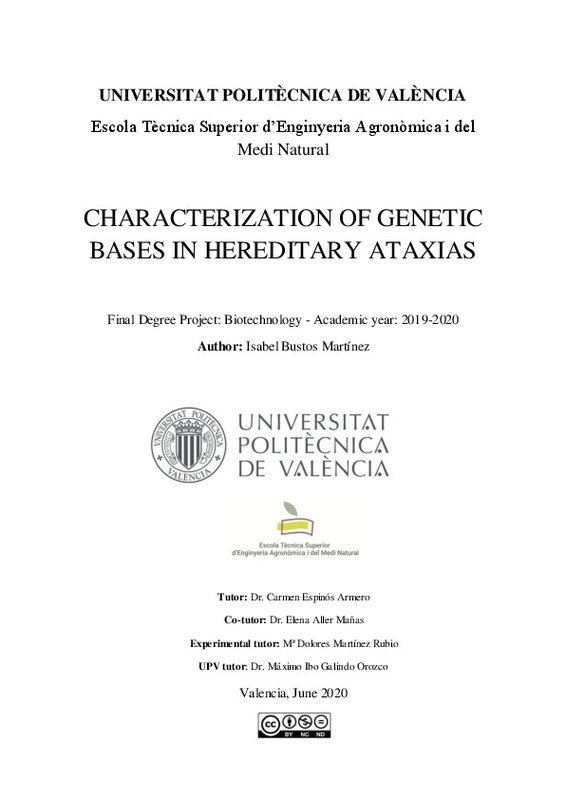|
Resumen:
|
[ES] Las ataxias hereditarias constituyen un grupo heterogéneo de trastornos del movimiento
caracterizados principalmente por una afectación progresiva en la estabilidad de la marcha y la
coordinación asociada a degeneración ...[+]
[ES] Las ataxias hereditarias constituyen un grupo heterogéneo de trastornos del movimiento
caracterizados principalmente por una afectación progresiva en la estabilidad de la marcha y la
coordinación asociada a degeneración del cerebelo, pudiendo haber afectación del habla y de
movimientos oculares. Según el tipo de herencia se clasifican en ADCAs ( Autosomal Dominant
Cerebellar Ataxias ) and ARCAs ( Autosomal Recessive Cerebellar Ataxias ). Las SCAs
( Spinocerebellar Ataxias ) constituyen la forma más común de ADCAs. Hasta la fecha se han
descrito más de 40 subtipos, siendo la más frecuente la SCA3. Sin embargo, la prevalencia en
cada territorio varía debido a efectos fundadores, siendo la SCA36 la más representativa en
Galicia (21,3%). Respecto a las ARCAs las más relevantes son la ataxia de Friedreich y las
ataxias con apraxia oculomotora tipo 1 y 2. El diagnóstico es complejo, especialmente en
ADCAs debido a solapamientos clínicos, y por su acusada heterogeneidad genética. Por ello es
importante el diagnóstico genético que permite establecer un diagnóstico definitivo y certero.
En el presente trabajo se incluye el estudio de la secuenciación de exomas (WES, Whole Exome
Sequencing ) de tres familias con ataxia hereditaria (fATX-163, fATX-166 y fATX-167) que han
resultado negativas para todas las pruebas genéticas realizadas con anterioridad. Los datos
brutos del WES se filtraron y se seleccionaron siguiendo un protocolo propio, y se obtuvo una
lista de variantes candidatas. Posteriormente, se realizó su validación mediante secuenciación
Sanger, y en la familia fATX-167 se estudió la segregación de las mutaciones seleccionadas
para determinar una posible asociación con el fenotipo clínico.
La SCA36 es una ADCA producida por expansiones del hexanucleótido GGCCTG en el intrón
1 del gen NOP56. El objetivo principal fue el diseño y la optimización de un test genético eficaz
para detectar alelos expandidos (patológicos) mediante RP-PCR ( Repeat-Primed PCR) y
electroforesis capilar. Además, realizamos un cribado en una cohorte de 52 pacientes con ataxia
hereditaria sin diagnóstico genético establecido, incluyendo pacientes de las familias fATX-163,
166 y 167.
Uno de los desafíos a los que se enfrenta el diagnóstico molecular actualmente es la
interpretación de las mutaciones; es decir, establecer que el cambio identificado es la mutación
causal de la enfermedad. En este TFG, se ha investigado la variante POLR3A c.3688G>A
identificada en un paciente de una familia con ataxia espástica. Los predictores in silico
mostraban que este cambio, pese a localizarse en el exón 28 del gen, podría alterar el splicing,
por lo que se llevó a cabo un análisis de transcritos en el probando (retrotranscripción del RNA,
amplificación de un fragmento que contenía el cambio de interés, y posterior electroforesis y
secuenciación de la banda purificada).
[-]
[EN] Hereditary ataxias constitute a heterogeneous group of movement disorders mainly
characterized by progressive impairment of gait stability and coordination associated with
cerebellar degeneration, sometimes affecting ...[+]
[EN] Hereditary ataxias constitute a heterogeneous group of movement disorders mainly
characterized by progressive impairment of gait stability and coordination associated with
cerebellar degeneration, sometimes affecting the speech and eye movements. According to the
type of inheritance, they can be classified in ADCAs ( Autosomal Dominant Cerebellar Ataxias )
and ARCAs ( Autosomal Recessive Cerebellar Ataxias ). SCAs ( Spinocerebellar Ataxias) are the
most common forms of ADCAs. More than 40 subtypes have been described so far, being
SCA3 the most frequent one. However, the prevalence varies among territories due to founder
effects, being SCA36 the most representative in Galicia (21.3%). Regarding ARCAs, the most
relevant ones are Friedreich s ataxia and ataxias with oculomotor apraxia types 1 and 2.
Diagnosis is complex, especially when it comes to ADCAs due to clinical overlaps and high
genetic heterogeneity. Therefore, genetic diagnosis is important to establish a definitive and
accurate diagnosis.
This project includes the study of the whole exome sequencing (WES) of three families with
hereditary ataxia (fATX-163, fATX-166 and fATX-167) that were negative for the prior genetic
tests performed. Raw data from WES were filtered and selected following a pipeline developed
in the laboratory, and a list of candidate variants was obtained. Then, validation was performed
through Sanger sequencing, and in family fATX-167 the selected mutations were investigated in
order to determine their possible correlation with the clinical phenotype.
SCA36 is an ADCA caused by hexanucleotide GGCCTG expansion in intron 1 of NOP56 gene.
The main objective was to design and optimize an efficient genetic test to detect expanded
alleles (pathologic) through RP-PCR ( Repeat-Primed PCR) and capillary electrophoresis.
Furthermore, a screening was performed in a 52-patient cohort having hereditary ataxia without
genetic diagnosis, including patients from families fATX-163, 166 and 167.
Nowadays, molecular diagnosis is facing challenges such as mutation s interpretation; in other
words, determine whether the identified variant is the disease-causing mutation. In this TFG, the
variant POLR3A c.3688G>A was analyzed. This variant was detected in a patient of a family
suffering from spastic ataxia. In silico predictors revealed that this mutation, despite being
located in exon 28 of the gene, could affect the splicing. Therefore, transcript analysis was
performed in the proband (RNA retrotranscription, amplification of the region containing the
target mutation, and subsequent electrophoresis and sequencing of the purified band).
[-]
|




![PDF file [Pdf]](/themes/UPV/images/pdf.png)



